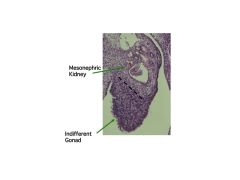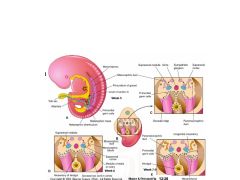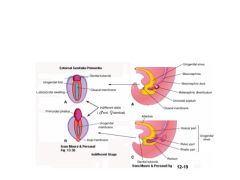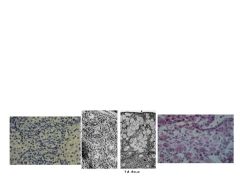![]()
![]()
![]()
Use LEFT and RIGHT arrow keys to navigate between flashcards;
Use UP and DOWN arrow keys to flip the card;
H to show hint;
A reads text to speech;
37 Cards in this Set
- Front
- Back
|
What three things do you need in order to develop a reproductive system?
|
Gonads, Duct system, External genitalia
|
|

In the four week embryo, study where the indifferent gonad forms in relation to the mesonephric kidney.
|

It is forming at the Ventromedial aspect of the UG ridge.
|
|
|
Where does the indifferent gonad form?
|
Within the ventromedial aspect of the UG ridge?
|
|
|
So, you have the gonads forming via epithelial proliferation at the ventromedial aspect of the UG ridge. How do the germ cells get to this area?
|

The germ cells arise in hindgut and travel via the dorsal mesentary to populate the gonads.
|
|
|
Where do supporting cells of the gonads derive from?
|
The epithelial ceolom
|
|
|
What are the cells in males and different in females, that produce sex hormones?
|
Leydig cells in Males and Thecal cells in Female.
|
|
|
What are the precursor cells of the Leydig/Thecal cells?
|
UG Mesenchyme within the UG ridge.
|
|
|
What is the role of the Gubernaculum in both the male and female?
|
It guides the gonads to their definitive location.
|
|
|
There are two duct systems that develop during the indifferent stage. What are they?
|
Mesonephric Duct and the Paramesonephric Duct
|
|

Initially the mesonephric duct is essentially the same as the kidney. Then the paramesonephric duct appears adjacent to each mesonephric duct. What happens to both of them over time?
|

The mesenephric ducts remain separated and serve the gonads. The paramesonephric duct becomes the vagina or penis.
|
|

At 4-6 weeks, the sexually undifferentiated embryo has? (three points)
|

1. a pair of undifferentiated gonads
2. two sets of ducts (para/mesophrenic) 3. Elevations and folds around the opening of the UG sinus. |
|

Which cells are male gonads and which are female?
|

The two on the L are males - notice the strands that ultimately open up during puberty.
The two on the R are female - notice the round cells - oocytes? |
|
|
What is cryptorchidism?
|
It is failure of testis to descend into scrotum and remain in the abdomen. In females, failure of ovaries to descend into pelvis.
|
|
|
In the female, the gubernaculum ultimately becomes:
|
The ligament of the ovary. Connecting the ovary to the uterus.
|
|
|
In males, the derivatives of the mesonephric ducts are (4):
What one structure comes from the mesonephric tubule? |
1. Duct of epididymis
2. Ductus (vas) deferens 3. Ejaculatory duct 4. Seminal vesicle -- Efferent ductules come from the tubules. |
|
|
Note that in addition to the duct system, the presence of androgen also promotes the development of what?
|
The prostate gland
|
|
|
Note that the mesonephric ducts are dependent on what hormone? What does this mean in the male vs female?
|
Dependent on Androgen. This means the ducts develop further into males. In females, the mesonephric ducts atrophy
|
|
|
What is MIS and what affect does it have on the male? What is it produced by?
|
Mullerian Inhibitory Substance stimulates the regression of the paramesonephric ducts. Produced by Sertoli cells.
|
|
|
In female, absence of MIS promotes growth and differentiation of the:
|
Paramesonephric ducts.
|
|
|
In female, what is the fate of the paramesonephric ducts?
|
They become oviduct.
|
|
|
Note: the paramesonephric ducts & pelvic part of the UG sinus interact with each other to form the vagina.
|
a
|
|
|
During the indifferent stage, the interior of the definitive UG sinus is remodeled. For the pelvic portion, what does the male and female remodel to? What about the phallic portion.
|
Pelvic Portion:
Male = distal prostatic & membranous urethra Female = part of vagina __________________ Phallic Portion: Male = penile urethra Female = vestibule |
|
|
Note that the gonad is bipotential. If SRY is positive, gonad becomes ? . If SRY is negative, gonad becomes ? .
|
Positve SRY = male testes
Negative SRY = female ovary |
|
|
Re internal genitalia differentiation, the male ducts are called ? and include? The females ducts are called ? and include ?
|
Male = Wolffian: Epididymis, vas deferens, seminal vescles
Female = Mullerian: uterus, tubes, upper vagina |
|
|
Interestingly, if there are problems with the genitalia, you always have to check out which system bc they are associated.
|
Renal
|
|
|
What hormone is responsible for causing regression of Mullerian ducts? Which sex does this lead to?
|
AMH - anti-mullerian hormone. Brings about males.
|
|
|
If there's ambiguous genitalia with a male karyotype, there's not enough testosterone. Why might this be? (he gave 4 examples)
|
Testosterone:
1. Synthesis (lack thereof) 2. Receptor defects 3. End organ conversion 4. Anti-mullerian hormone deficiency (internal) |
|
|
If there's ambiguous genitalia with a female karyotype, there's too much androgen. Why might this be? (he gave 2 examples)
|
1. High intake or production
2. Aromatase deficiency |
|
|
Clinically, how is male or female defined? (3 points for each)
|
Male:
1. Y-chrom 2. No uterus 3. Testes Female: 1. No Y chromosome 2. Uterus 3. No testes |
|
|
For the first case a 17yo girl with now breast development or pubic hair. Her karyotype is XY but lost testes and not testosterone. Since she IDs as a female, she'll require estrogen for development and protection of bones.
|
a
|
|
|
For case 2 - female with adequate breast development. She is producing estrogen and not much testosterone. She's XY and high testosterone but there's a receptor problem. (see back for treatment)
|
She has Complete Androgen Insensitivity. Here testes are producing testosterone that is being aromatized into estrogen. However, you want to remove them bc they might become malignant. You do this after pubertal development. After you remove testes you must estrogen treat her (if she had a uterus, you'd have to give her progesterone to counter estrogen - it might change uterus tissue into tumor).
|
|
|
For case 3 with the XX girl producing too much androgen, what is the physiological problem with her? What's the clue?
|
Deficiency of 21-hydroxylase. Clue is she didn't have high blood pressure.
|
|
|
What is the treatment for the XX girl overproducing androgen?
|
She needs cortisol to shut down stimulation of adrenal gland.
|
|
|
What hormone is responsible for external genitalia?
|
Dihydrotestosterone
|
|
|
Which of the following is NOT a characteristic of complete androgen insensitivity in a 28 yo phenotypic female?
|
Normal adult female testosterone level.
|
|
|
Deficiency of 17Alpha-hydroxylase is: (genetic)
|
Autosomal recessive
|
|
|
Mullerian-inhibiting substance is secreted by:
|
Sertoli cells
|

